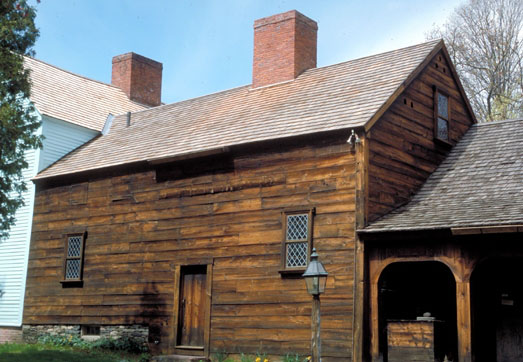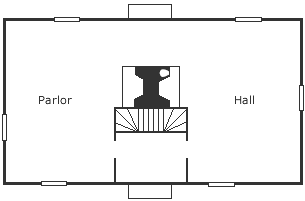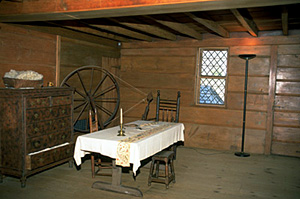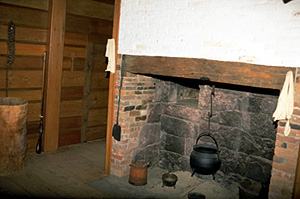Exploring Architecture
Post Medieval English / Early Colonial Style - Northern Version, 1600-1740
Wells-Thorn House - Southern Ell
The Street, Deerfield, MA
Built 1747

Chimney
Post Medieval English homes typically had a center chimney. Constructed with hand-made bricks, it was designed to heat the entire home and provide it with a cooking hearth. It needed to do this without taking up much space or smoking out the inhabitants. On the first floor, each room had its own fireplace with an individual flue. All these flues then met at the upper chimneystack and vented out the top. The chimney now on the Well-Thorn House is from a later period. The original would have been a step-back.
Roof
Post Medieval English roofs were very steeply pitched, side-gabled, and covered with thatch. In Europe this style allowed the roof to shed water quickly. In the New World colonies the steep pitch was favored because it also allowed snow to slide off. The thatch, however, was a problem. It was soon replaced with hand-split wooden shingles, which held up better to the high winds, ice and snow.
Weatherboard
In the Northern Colonies of the New World, homes were most often sided with weatherboard. These are long, wide boards (often pine) attached onto the framing of a house. Just like a bird’s feathers they overlap, creating a barrier that protects the house from the elements like rain, snow, cold and wind. On this building the weatherboards were left unpainted. Many Post Medieval English homes stood without paint for a very long time. Why? Paint was a luxury not everyone could afford.
Windows
There are few windows in Post Medieval English homes (the word “window” derives from “wind hole”). Windows (and doors) created holes in the protective “armor” of a house. They made the inhabitants vulnerable and were located wherever light was needed, not where design dictated. When closed they let in just enough light for the household to function. When open they allowed for airing-out of the house. The casement windows on the Wells-Thorn House are made of diamond-shaped panes of glass called “quarrels”. As you might imagine, this design has its roots in Europe. Under the roof on the front and back of the house are little shuttered windows. Called clerestory windows they let light into the small, half-story garret.
Door
The asymmetrically placed board and batten door was designed to let people in and to keep unwanted guests and harsh weather out. It was plain, solid and strong. The large hinges, handles and locks are of hand-forged iron, probably created by a local blacksmith.
The Wells-Thorn House
The Wells-Thorn House is a big building that has been around for
a very long time. It was built in many sections and in many styles
over the course of the 18th and 19th centuries.
Every house has bits and pieces that place it within a time, a place and an architectural style. This building was constructed in the Post Medieval English Style, a type of early American architecture tied to modest contemporary English cottages. What makes this structure Post Medieval English?
Most Post Medieval English homes were designed as safe havens, places to seek refuge from the frightening cold of New England winters and to eat, sleep, and do the chores necessary for people to survive. They were small, boxy houses only one and one-half stories high and one room deep. They had very steeply pitched roofs and their façades were simple and functional. While some had an overhang, others, like the Wells-Thorne House, did not. On the inside, homes were configured using the simple hall and parlor plan that featured a massive center chimney and a fireplace in each room. The upper floor, commonly called the garret, was unheated. It may have been used for sleeping, but mostly for storage.
Most Post Medieval English homes had asymmetrical façades. Imagine a straight line running down the center of this building's exterior. Does each half have the same number of windows and doors? Look carefully. Don't forget the tiny windows that let light into the garret. Are they evenly spaced? In other words, is one side of the façade a mirror image of the other? If not, it is asymmetrical.
History
Ebenezer
Wells and his wife, Abigail Barnard Wells, lived in this home
with their two slaves --Lucy
and Cesar. They had no children. From 1747 to 1749 this ell may
have been used as both living space and a tavern,
which Wells had a license for. In 1963 Historic Deerfield, Inc.
restored the entire home.
Floor Plan
 In Post Medieval English homes, the interior was laid out according to a symmetrical hall and parlor plan. This plan featured a center chimney with rooms of equal size on either side. In front of the chimney was an inner entryway called a porch and a stairway leading up to the garret. In Post Medieval English homes, the interior was laid out according to a symmetrical hall and parlor plan. This plan featured a center chimney with rooms of equal size on either side. In front of the chimney was an inner entryway called a porch and a stairway leading up to the garret.
Interior
 |
|
 |
|
To the right of the chimney was the parlor.
Photo courtesy of Historic Deerfield, Inc., photography by Amanda Merullo
|
|
To the left was the hall: room for cooking, eating, and working (and sleeping if the family was big enough or the nights cold enough).
Photo courtesy of Historic Deerfield, Inc., photography by Penny Leveritt
|
Glossary of Architectural Terms | Architectural Resources
top of page
|








 In Post Medieval English homes, the interior was laid out according to a
In Post Medieval English homes, the interior was laid out according to a